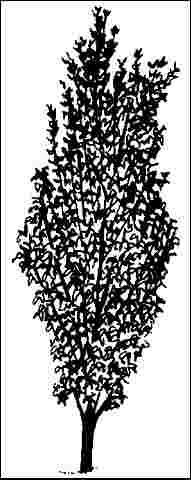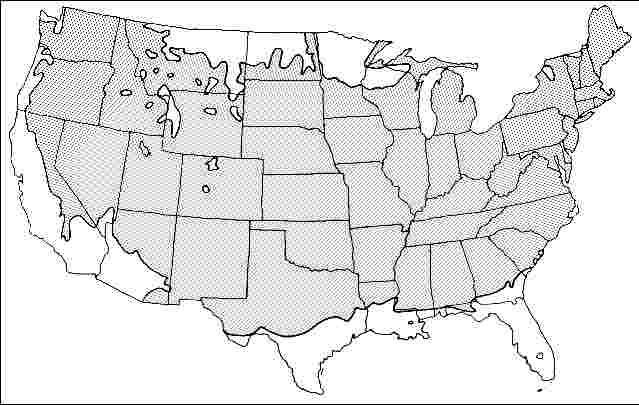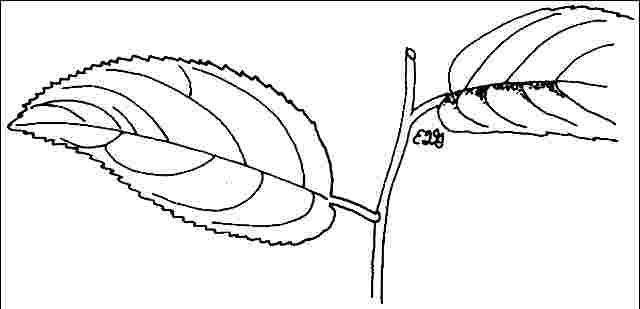Introduction
One of the many selections of flowering crabapple, Siberian crabapple is a deciduous tree with an unusually narrow crown for a crabapple. Reaching about 30 to 35 feet in height, this cultivar only grows to about 8 or 10 feet wide. The very fragrant blooms are 1.5 inches in diameter, are pink when in bud but open up to white. The blooms are followed in fall by long-lasting, bright red, or yellow fruits which are very popular with the birds or can be used to make a delicious jelly. This cultivar may make less of a mess beneath the tree than others due to a light fruit set.

Credit:
General Information
Scientific name: Malus baccata
Pronunciation: MAY-lus back-AY-tuh
Common name(s): Columnar Siberian crabapple
Family: Rosaceae
USDA hardiness zones: 3B through 8A (Figure 2)
Origin: not native to North America
Invasive potential: not assessed/incomplete assessment
Uses: sidewalk cutout (tree pit); espalier; street without sidewalk; specimen; container or planter; trained as a standard; tree lawn 3–4 feet wide; tree lawn 4–6 feet wide; tree lawn > 6 ft wide; highway median; bonsai

Credit:
Description
Height: 30 to 35 feet
Spread: 8 to 10 feet
Crown uniformity: symmetrical
Crown shape: upright/erect, columnar
Crown density: dense
Growth rate: moderate
Texture: medium
Foliage
Leaf arrangement: alternate (Figure 3)
Leaf type: simple
Leaf margin: serrate, serrulate, crenate
Leaf shape: elliptic (oval)
Leaf venation: pinnate, brachidodrome
Leaf type and persistence: deciduous
Leaf blade length: less than 2 inches, 2 to 4 inches
Leaf color: green
Fall color: yellow
Fall characteristic: not showy

Credit:
Flower
Flower color: white/cream/gray
Flower characteristics: very showy
Fruit
Fruit shape: round
Fruit length: less than 0.5 inch
Fruit covering: fleshy
Fruit color: red, yellow
Fruit characteristics: attracts squirrels/mammals; showy; fruit/leaves not a litter problem
Trunk and Branches
Trunk/bark/branches: branches don't droop; not showy; typically multi-trunked; thorns
Pruning requirement: little required
Breakage: resistant
Current year twig color: brown
Current year twig thickness: thin, medium
Wood specific gravity: unknown
Culture
Light requirement: full sun
Soil tolerances: sand; loam; clay; acidic; alkaline; well-drained; occasionally wet
Drought tolerance: moderate
Aerosol salt tolerance: low
Other
Roots: not a problem
Winter interest: yes
Outstanding tree: no
Ozone sensitivity: sensitive
Verticillium wilt susceptibility: resistant
Pest resistance: resistant to pests/diseases
Use and Management
Pruning should be completed by late spring to ensure flower buds are not removed. Trees normally branch low and need little training to develop a central trunk. Low branches will probably not need to be removed for vehicle and pedestrian clearance due to the upright growth habit. Crabapples need occasional thinning to eliminate water sprouts or crossed branches and to open up the crown, to help prevent leaf diseases. This cultivar is very susceptible to scab and fireblight.
Siberian crabapple grows in moist, well-drained, acid soil in full sun locations for best flowering and disease resistance. It is not extremely drought tolerant and not adapted to alkaline soil, so should not be grown in extreme west Texas or similar environments. It grows well on the Texas panhandle, where there are a number of apple orchards.
The cultivar 'Jackii', grows into USDA hardiness zones 2 to 7, has upright-spreading habit, grows 20 to 30 feet high and 15 feet wide, has pink-tinged white buds, purplish or maroon-red fruit, and is reportedly disease-resistant. There are many cultivars—be sure to select those which are disease-resistant. Contact the International Ornamental Crabapple Society (www.crabapplesociety.org) for more information on crabapples.
Trees produced on their own roots are preferred. Grafted or budded trees are more uniform in habit and performance than seedling trees.
Pests
Aphids infest branch tips and suck plant juices.
Fall webworm makes nests on the branches and feeds inside the nest. Small nests can be pruned out or sprayed with Bacillus thuringiensis.
Scales of various types are usually controlled with horticultural oil.
Mites are too small to see easily so can cause much foliage discoloration before being detected. Mites are usually controlled with horticultural oil.
Tent caterpillar builds tents or nests in trees in early summer or late spring. Feeding occurs outside the nest. Small nests are pruned out or simply pull the nest out of the tree and crush the caterpillars. Do not burn nests while they are still in the tree since this can cause severe damage to the tree and could start an uncontrolled fire.
Diseases
Siberian crabapple is susceptible to scab. Infection takes place early in the season and dark olive-green spots appear on the leaves. In late summer the infected leaves fall off when they turn yellow with black spots. Infected fruits have black, slightly raised spots. Use resistant varieties.
Fire blight susceptible trees have blighted branch tips. Leaves on infected branch tips turn brown or black, droop, and hang on the branches. The leaves look scorched as by a fire. The trunk and main branches become infected when the bacteria are washed down the branches. Cankers form and are separated from adjacent healthy bark by a crack. The infected bark may be shredded. Use resistant cultivars when available, and do not over-fertilize.
Powdery mildew is a fungus which coats leaves with mycelia resembling white powder.
Rust causes brown to rusty-orange spots on the leaves. Badly spotted leaves fall prematurely. Redcedars are the alternate host.
Crabapples are subject to several canker diseases. Prune out infected branches, avoid unnecessary wounding, and keep trees healthy.